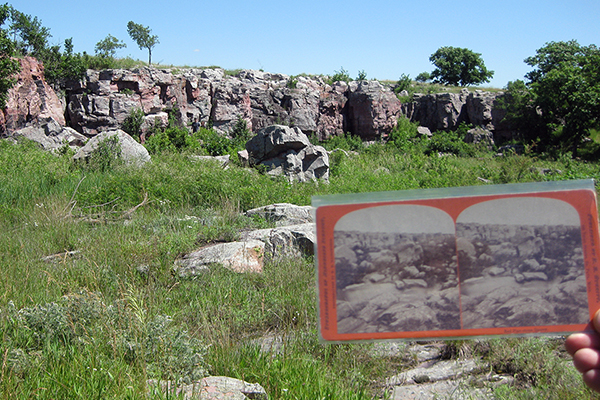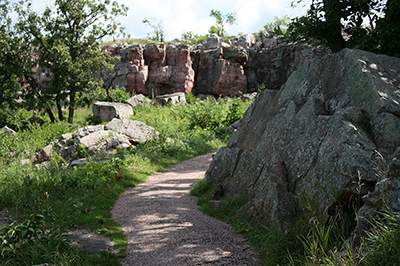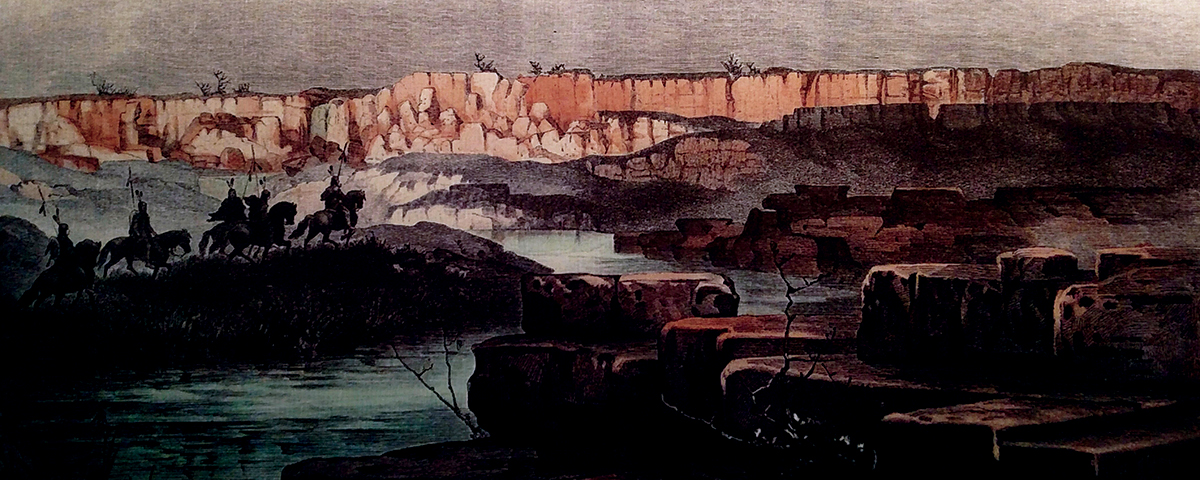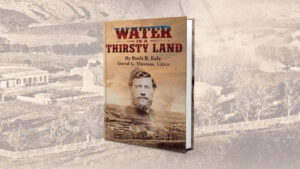The ceremonial pipe is central to the religious practices and cultural traditions of many Indian tribes in the United States. It comprises two basic parts—a wooden stem, representing the male, and a stone bowl, representing the female. When joined together, the complementary parts represent the people as a whole. Among many tribes the origin of the most sacred pipe bowls are the quarries at Pipestone, Minn., in the southwest corner of the state.
According to Sioux tradition the Great Spirit sent a flood to cleanse the Earth. The blood of those killed in the flood seeped into the ground and congealed into the present-day pipestone formation. For centuries various tribes have gathered at the site to quarry the soft red stone and fashion it into ceremonial pipe bowls. When passing around the pipe, people send up prayers with the smoke.
‘All the things of the universe are joined to you who smoke the pipe—all send their voices to Wakan Tanka, the Great Spirit. When you pray with this pipe, you pray for and with everything’ —The Sacred Pipe, by Black Elk, Oglala Lakota holy man
“The pipestone quarries are a wellspring,” says Dave Rambow, former office manager of the Pipestone Indian Shrine Association. “The elements of the pipe cover sky, earth, water and wind. The stone bowl is of the earth, the wood stem is of the earth, the smoke is of the earth but ascends into the sky, carrying the prayers to the Great Spirit.”
Geologists believe the pipestone rock formation originated more than 1.6 billion years ago as ancient rivers and streams deposited layers of red clay atop sandstone. Over the millennia the watercourses deposited additional layers of sand atop the clay. The overlying sand ultimately metamorphosed into 10- to 15-foot thick layers of hard Sioux quartzite, and the resulting heat and pressure compressed the clay into a layer of soft pipestone up to 18 inches thick.
Archaeological digs in the region have turned up signs of human activity dating back some 9,000 years, while evidence suggests people have used the southwest Minnesota pipestone quarries for perhaps 3,000 years. Soft enough to carve yet durable enough to permit extended use, pipestone became a prized trade commodity throughout North America. Members of such tribes as the Iowa, Oto, Dakota, Lakota, Mandan, Chippewa, Omaha, Ponca, Sauk and Fox traveled long distances to quarry the stone. Tradition held that pilgrims to the sacred quarries were to refrain from violence while on-site, even when encountering members of warring tribes—though some have challenged the veracity of that claim.
Early French-Canadian fur traders, known as coureurs des bois (“runners of the woods”), heard of the quarries, and one of them, Pierre-Charles Le Sueur, is thought to have been the first European to visit the site, sometime in the late 1600s. Meriwether Lewis and William Clark knew of the quarries but did not see them firsthand during their 1804–06 expedition. “The country watered by this last river [Pipestone Creek] is remarkable for furnishing a red stone, of which the savages make their most esteemed pipes,” Lewis wrote. “The Indians of many nations travel vast distances to obtain this stone, and it is asserted…that all nations are at peace with each other while in this district.” While wintering in the region in 1831–32, New York–born explorer and fur trader Philander Prescott and party visited the quarries. They tried blasting through the quartzite with gunpowder, to little effect, and after a full day’s digging collected only enough pipestone to make 20 pipes.
In 1832 artist George Catlin traveled up the Missouri River to record life among the various tribes and render portraits of individual Indians. Two of his subjects—a Mandan chief and a Ponca chief—told the artist of the “fountain of the red pipe,” gifted him with pipes and insisted the Sioux Indians had since claimed the quarries as their own. Obsessed with seeing the site firsthand, Catlin set out to visit it in 1836 with English travel companion the Rev. Robert Wood. At the Traverse des Sioux river crossing, some 150 miles from the quarries, the travelers encountered a group of hostile Santee Dakotas who claimed to be the protectors of the pipestone. The Santees detained the pair, warning them “no white man has been to the red pipe, and none shall go.” After convincing the Sioux they weren’t government agents, Catlin and Wood pressed on, hiring French-Canadian trader Joseph La Framboise of the American Fur Co. to guide them the last 50 miles. On August 17 the trio reached the pipestone quarries. Catlin not only wrote about and painted the quarries but also took samples of the sacred pipestone. These he sent to Boston-based geologist Charles Thomas Jackson, who analyzed them and deemed them a new rock form that he named catlinite.
Though Catlin had assured the Sioux he was not a federal agent, his popular paintings and writings brought the pipestone quarries to the government’s attention. In 1838, two years after guiding the artist to the quarries, La Framboise led a 15-member Corps of Topographical Engineers survey team to the site. Funded by the War Department, the party was led by French geographer and Renaissance man Joseph Nicollet and included young Lieutenant John Frémont, the future “Pathfinder” of expeditions still farther west. The purpose of the Nicollet expedition was to map the region between the upper Mississippi and Missouri rivers. The party reached the pipestone quarries in late June and stayed nearly a week. Nicollet asked La Framboise to carve expedition members’ initials and the month and year into one of the rock ledges. While alone and busily doing so, the guide was startled by a hand on his shoulder and a voice asking what he was doing. Fortunately for La Framboise his interrogator was an old friend from the Wahpekute Dakota tribe. The friend and his party had been tailing the expedition for several days. Nicollet invited the Wahpekutes to camp alongside his men, and the Indians were delighted when the soldiers used gunpowder to blast through the upper layer of quartzite to get to the pipestone. On the Fourth of July a high-spirited Frémont clambered atop a rocky bluff with an American flag and then jumped a 5-foot gap to what is known today as Leaping Rock, where he unfurled and planted the banner. The expedition’s visit was peaceful, and it soon moved on to map the rest of the region.
Awareness of the extraordinary pipestone site dramatically increased with the 1855 publication of Henry Wadsworth Longfellow’s Song of Hiawatha. His popular epic poem directly references “the great Pipestone Quarry” and deifies “Gitche Manito, the mighty, He the Master of Life,” who stood atop the quarries and instructed the Indian nations to cease their warring, fashion the red stone into pipes and smoke to peace.
Legend aside, various exploratory and scientific surveys to the quarries continued into the late 1800s. Under the increasing public scrutiny, the Indians of the region struggled to retain control of the site. In 1858 the Yanktons signed a treaty with the U.S. government that sent them westward 150 miles to a reservation in present-day South Dakota. Thanks to a provision insisted on by Chief Struck-by-the-Ree, however, the Yanktons retained rights to 648-acre tract of land encompassing the quarries, with a federal guarantee they would have free and unfettered use of the quarries.
In the fall of 1866 Massachusetts-born geologist Ferdinand Hayden, who would soon launch his extensive surveys of the Rocky Mountain West, visited the site for a day. Remarking on the quantity of “rude iron tools scattered about,” he questioned the antiquity of the site, though he was impressed by the amount of labor the Indians had expended in “throwing off” the quartzite to obtain the pipestone.

Englishman William Illingworth, whose stereoscopic images of Pipestone’s waterfalls, cliffs and quarries fueled public interest in the region, was driven by a love for the scenic outdoors. Born in Leeds on Sept. 20, 1842, Illingworth had settled with his family in St. Paul, Minn., by 1850. As a young man he moved first to Chicago and then Philadelphia to study photography, returning to St. Paul in 1863 to open a studio. By 1866 he was married with a young son and making a good living as a portrait photographer. But he was always looking for new opportunities.
The public had become enthralled with stereoscopic views of scenery and daily life, so that year Illingworth partnered with George Bill to take 30 stereographs of Captain James Liberty Fisk’s fourth wagon train from St. Cloud, Minn., to the Montana Territory goldfields. Unable to afford to publish the views themselves, they sold the negatives to John Carbutt, who took credit for the photos. It was a portent for Illingworth, who had financial trouble most of his life, was widowed twice and divorced once.
In the early 1870s, while taking stereoscopic views of the construction of the Northern Pacific Railroad, Illingworth may have met Lt. Col. George Custer and other members of the 7th Cavalry, which had been assigned to protect the surveyors and work crews. In 1874 Captain William Ludlow, chief engineer of the military Department of Dakota, signed on Illingworth as a teamster, but his real job was to take stereoscopic views of Custer’s Black Hills Expedition, and he made 70 wet plate negatives. “Our photographer has obtained a complete set of magnificent stereoscopic views of Black Hills scenery,” Custer wrote wife Libbie from the field. Illingworth’s best-known photo is of Custer, scout Bloody Knife, orderly Private John Noonan and Ludlow posing with a grizzly bear Custer shot in the Black Hills. Illingworth, wrote St. Paul Daily Press reporter Fred Power, “has had the good fortune not only to get some good pictures but also to prove himself to be one of the best shots on the expedition, which is considerable.”
After the Black Hills Expedition, Illingworth continued to photograph scenic vistas (many of them in Minnesota), pioneers and Indians. After the divorce from his third wife in 1888, his business and health declined and his alcohol intake increased. On March 16, 1893, he ended his life with a shot to the head from his hunting rifle. Fortunately, much of his work survives. The South Dakota Historical Society acquired the Black Hills Expedition negatives, while the Minnesota Historical Society has a wide variety of his images. —B.M.
Another notable visitor was photographer William Illingworth (see sidebar, right), best known for later accompanying Lt. Col. George Armstrong Custer’s 1874 Black Hills Expedition. In 1870 he was a partner in the Sioux City, Iowa, photographic firm Gurnsey & Illingworth when he learned of the pipestone quarries and became fascinated. So on May 28 he packed his gear and supplies into a wagon, headed north more than 100 miles along the Big Sioux River to the falls of the Big Sioux and then on to the pipestone quarries and adjacent waterfalls. He took more than 20 stereoscopic images of the quarries and falls, which looked even more dramatic in the heavy rains that drenched him every day but one during his trip. When Illingworth returned home on June 8, The Sioux City Journal reported he was “so much of a ‘sight’ that he was immediately photographed by Mr. Gurnsey.” Gurnsey’s photo of his intrepid partner has yet to surface.
Nine days later the newspaper ran the following seemingly inconsequential notice: “Charles Bennett of Le Mars [Iowa] is in the city.” Bennett, perhaps inspired by Illingworth’s photographs, also became obsessed with visiting the quarries, which he did three years later with wife and friends. Soon thereafter he hatched a plan to start a town near the site, convinced the waterfalls would draw tourists. In 1874 he and two friends registered homestead claims in the area, and within a couple years he platted the townsite of Pipestone and was its primary booster. As Bennett anticipated, the town soon thrived as tourists flocked to the quarries and waterfalls.
In 1881 German artist Rudolf Cronau visited the pipestone quarries, befriended such tribal leaders such as Struck-by-the-Ree, Crow King, Gall and Sitting Bull and rendered heroic portraits of Indians at the quarries. Through Cronau’s paintings and writings the German people came to share Americans’ fascination with the quarry and its Indian overseers.
As the century wore on, it became more and more difficult for Indians to travel from their reservations to the quarries. In their absence white settlers encroached on the protected parcel to farm and graze animals and to quarry pipestone as souvenirs for the tourists. In 1887 Captain J.W. Bean and 10 soldiers peaceably evicted the squatters and replaced the boundary markers. Regardless, through the turn of the century the Yanktons fought a continual battle to retain control of the site, a number of them relocating there to quarry the stone and craft their pipes. In 1893, against their wishes and over their protests, the federal government built an Indian school and allowed a railroad right-of-way through the parcel. Government officials repeatedly tried to strip the Yanktons’ rights to the quarries, and the tribe responded by going to court. Finally, in 1929 the government bought the land from the Yanktons for $328,558.90, though it granted them the right to continue quarrying their sacred stone.

Pipestone National Monument lies just outside Pipestone, Minn., 25 miles north of I-90. The monument is open year-round, though hours vary by season. The ¾-mile Circle Trail leads through tallgrass prairie past active quarries to Winnewissa Falls and other cascades. Highlights include the ledge on which guide Joseph La Framboise carved the initials of 1838 Nicollet expedition members, as well as Leaping Rock, to which John Frémont made his Fourth of July leap that year with the American flag. Visitors are welcome to watch as quarriers labor to reach and remove the pipestone. The visitor center includes a museum and continually shows an award-winning 22-minute interpretive film, Pipestone: An Unbroken Legacy. From April to October on-site artisans demonstrate the art of carving and shaping pipes from the sacred stone. —B.M.
In 1937 Congress established Pipestone National Monument (see sidebar, left), tasking the National Park Service with protecting and managing its natural resources, while authorizing members of all tribes to quarry pipestone for traditional purposes. Several families have carried on the pipe-making tradition, passing the skills from generation to generation. In 1946 the NPS began issuing permits to Indians interested in using the stone, though the number of permits remained low until interest in pipe-making rekindled in the 1960s.
Today, on obtaining a permit, enrolled members of federally recognized tribes can remove the stone at no cost. The waiting list is long, however, as digging is limited to 56 active quarries. A stalwart individual or a few close family members typically work a quarry. Before starting work, depending on their traditions, the quarriers may purify themselves through a sweat lodge ceremony or by burning sage, or they may leave an offering or pray at the site. Regulations permit the use only of hand tools—sledgehammers, picks, chisels, wedges, shovels, pry bars, etc. Power tools, heavy equipment and explosives are forbidden. Quarriers first have to remove any plant cover and soil. Then comes the intense labor of breaking through the thick layer of hard Sioux quartzite. Experienced quarriers exploit natural cracks and fissures in the rock, driving wedges into them to bust out chunks of quartzite. Still, it may take crews months if not years to break through. On finally reaching the pipestone layer, quarriers must use caution to remove intact sheets of the soft stone, thus providing carvers as much workable material as possible.
The pipestone is relatively easy to work using saws, knives, files, rasps and sandpaper. Traditional pipe makers used buffalo fat to draw out the rich red luster of the pipestone; today many use beeswax. The finished product is truly a labor of love.
Wahpeton Sioux Travis Erickson, a fourth-generation quarrier and pipe artisan, has put 35 years of blood, sweat and tears into creating his exquisite pipestone bowls, some of which are on display at the Smithsonian Institution. “I can say there is a connection between me and the pipestone, between me and quarries,” Travis says of his life’s work. “It’s a spiritual connection.” MH
Bill Markley of Pierre, S.D., works for the South Dakota Department of Environment and Natural Resources and is a staff writer for Roundup, the membership journal of Western Writers of America.





